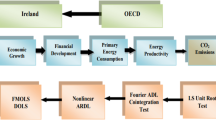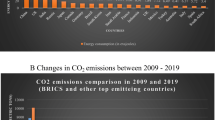Abstract
This paper empirically examines the nexus between energy consumption and the environmental quality conditioned to the energy mix in sub-Saharan African countries over the period 1990–2016. Using the panel threshold regression developed by Hansen (Econometrica 68:575–603, 1999) including 22 countries, the environmental quality is measured by the CO2 emissions. Results show that there is a non-linear relationship between energy consumption and CO2 emissions, and two threshold values of energy mix were found (68.53% and 88.86%). Then, our findings argue that energy consumption increases CO2 emissions when the energy mix is below 68.53%. However, when the energy mix is above 88.86%, energy consumption leads to a significant reduction in CO2 emissions. In addition, Gross Domestic Product and trade openness increase CO2 emissions, while rural population growth has a negative effect on CO2 emissions. Therefore, to achieve their environmental quality objectives, Sub-Saharan African countries have to focus their energy policies on renewable energy sources.
Similar content being viewed by others
Notes
The VIF calculates centred or uncentred variance inflation factors (VIFs) for the independent variables specified in a linear regression model.
References
Baek, J. (2016). Do nuclear and renewable energy improve the environment? Empirical evidence from the United States. Ecological Indicators, 66(352), 356.
Bölük, G., & Mert, M. (2015). The renewable energy, growth and environmental Kuznets curve in Turquie: An ARDL approach. Renewable and Sustainable Energy Reviews, 52, 587–595.
Choi, I. (2001). Unit root tests for panel data. Journal of International Money and Finance, 20, 249–272.
Danish, Z., & B. Wang, & Wang, Z. (2017). Role of renewable energy and non-renewable energy consumption on EKC: Evidence from Pakistan. Journal Clean Production, 156, 855–864.
Dong, K., Sun, R., Jiang, H., & Zeng, X. (2018). CO2 emissions, economic growth, and the environmental Kuznets curve in China: What roles can nuclear energy and renewable energy play? Journal Clean Production, 196, 51–63.
Dongan, E., & Seker, F. (2016). Determinants of CO2 emissions in the European Union: The role of renewable and non-renewable energy. Renewable Energy, 94, 429–439.
Dumitrescu, E.-I., & Hurlin, C. (2012). Granger non-causality test in a heterogeneous panel. Economic Modelling, 29, 1450–1460.
Economou, A. (2010). Renewable Energy Resources and Sustainable Development in Mykonos (Greece). Renewable and Sustainable Energy Reviews, 14(5), 1496–1501. https://doi.org/10.1016/j.rser.2009.11.008.
European Union, EU. (2018). European Union policy, strategy and legislation for 2030 environmental, energy and climate targets. Accessed at www.ec.europa.eu. 31 July 2020.
Gielen, D., Boshell, F., Saygin, D., Bazilian, M. D., Wagner, N., & Gorini, R. (2019). The role of renewable energy in the global energy consumption transformation. Energy Strategies Reviews, 24, 38–50.
Gonzalo, J., & Pitarakis, J.-Y. (2002). Model Choice Estimation and Inference in Single and Multi-threshold Models. Journal of Econometrics, 110(2002), 319–352.
Hansen, B. E. (1999). Threshold effects in non-dynamic panels: estimation, testing, and infer-ence. Journal of Econometrics, 93, 345–368.
Harbaugh, W. T., Levinson, A., & Wilson, G. M. (2002). Reexamining the empirical evidence for an Environemental Kuznets Curve. The Review of Economics and Statistics, 84(3), 541–551.
International Energy Agency, IAE. (2017). World Energy Outlook 2017: A world in Tranformation.
Ibrahim, M. H., & Law, S. H. (2014). Social capital and CO2 emission output relations: A panel analysis. Renewable and Sustainable Energy Reviews, 29, 528–534.
IRENA (2019). Climate change and renewable energy: National policies and the role of communities, Cities and Regions.
Kangyin, D., Ren**, S., & **ucheng, D. (2018). CO2 emissions, natural gas and renewables, economic growth: Assessing the evidence from China. Science of the Total Environment, 640–641, 293–302. https://doi.org/10.1016/j.scitotenv.2018.05.322.
Karl, T. R., Arguez, A., & Huang, B. (2015). Possible artifacts of data biases in the recent global surface warming hiatus. Science, 348, 1469–1472.
Kaya, Y. (1990). Impact of Carbon Dioxide Emission Control on GNP Growth: Interpretation of Proposed Scenarios”. Paper Presented at the IPCC Energy and Industry Subgroup, Response Strategies Working Group, Paris, France
Keleş, S., & Bilgen, C. (2012). Renewable energy sources in Turkey for climate change mitigation and energy sustainability. Renewable and Sustainable Energy Reviews, 16(7), 5199–5206. https://doi.org/10.1016/j.rser.2012.05.026.
Khattak, S. I., Ahmad, M., Khan, Z. U., & Khan, A. (2020). Exploring the impact of innovation, renewable energy consumption, and income on CO2 emissions: New evidence from the BRICS economies. Environmental Science Pollution Resource, 16, 1–16.
Martinez-Zarzoso, I., Bengochea-Morancho, A., & Morales-Lage, R. (2007). The impact of population on CO2 emissions: Evidence from European countries. Environmental and Resource Economics, 38, 495–512.
Martins, F., Felgueiras, C., & Smitkova, M. (2019). Analysis of fossil fuel energy consumption and environmental Impacts in European Countries. Energies, 12(6), 964.
Pata, K. U. (2018). Renewable energy consumption, urbanization, financial development, income and CO2 emissions in Turkey: Testing EKC hypothesis with structural breaks. Journal Clean Production, 187, 770–779.
Sarkodie, S. A., & Samuel, A. (2018). Renewable energy, nuclear energy and the environmental pollution: accounting for political institutional quality in South Africa. Science of the Total Environment, 643, 1590–1601.
Shafiei, S., & Salim, R. A. (2014). Non-renewable and renewable energy consumption and CO2 emissions in OECD countries: A comparative analysis. Energy Policy, 66, 547–556.
Sharif, A., Raza, S. A., Ozturk, I., & Afshan, S. (2019). The dynamic relationship of renewable and non-renewable energy consumption with carbon emission: A global study with the application of heterogeneous panel estimations. Renewable Energy, 133(2019), 685–691.
Stern, D. I., & Common, M. S. (2001). Is there an environmental Kuznets curve for sulfur? Journal of Environmental Economics and Management, 41(2), 162–178.
Zare, R., & Arman, S. E. (2017). Environmental Kuznets curve: New evidences based on a dynamic panel threshold model. Quarterly Journal of Quantitative Economics, 14(2), 215–232.
Author information
Authors and Affiliations
Corresponding author
Appendix
Appendix
See Tables 2, 3, 4, 5, 6, 7, 8, 9, 10, 11 and 12.
Rights and permissions
About this article
Cite this article
Bassongui, N., Nomo Alinga, D.N. & Mignamissi, D. Threshold effects of energy mix on environmental quality. J Bioecon 23, 163–178 (2021). https://doi.org/10.1007/s10818-020-09305-5
Accepted:
Published:
Issue Date:
DOI: https://doi.org/10.1007/s10818-020-09305-5




